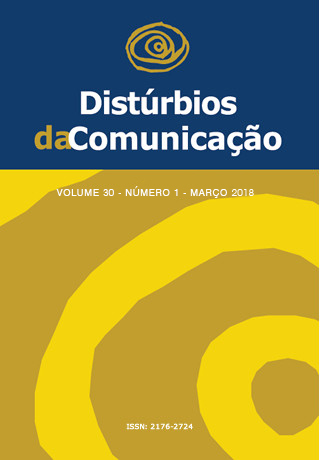Visual impairment x hearing abilities: performance of the central auditory processing abilities in the visually impairedditory processing abilities in the visually impaired
DOI:
https://doi.org/10.23925/2176-2724.2018v30i1p60-71Keywords:
Hearing, Visually Impaired Persons, Auditory Perception, Sensory Deprivation, Hearing Tests.Abstract
Introduction: In the absence of vision, the human brain needs to compensate this sensorial disability making adjustments so other senses equilibrate external perceptions. Objective: Compare the performance of the central auditory processing abilities between a group of visually impaired and a group with normal vision. Methods: Participants were divided in: study group (SG), composed by 13 visually impaired, that afterwards were subdivided accordingly with degree and type of the deficiency; and control group (CG), formed by the same number of participants with normal vision. Both were submitted to a questionnaire about their hearing history, meatoscopy, basic hearing assessment, composed by tonal and vocal audiometry, and impedance, being that participants with adequate auditory integrity and acuity passed to the execution of the tests for the central auditory processing assessment (SSW, MLD, DLCVS, PPS, RGDT). Results: It was observed that, in general, the SG obtained better result only in the left ear in competitive condition, in SSW test. In the MLD, there was statistical significant difference with higher overall average in the SG. In the DLCVS, in free attention, the occurrence of the general correct answers was higher in the CG, whereas, in directed attention, SG obtained higher overall average in the right attention and CG in the left attention. In the PPS and RGDT tests, it was observed that SG showed higher overall performance. Conclusion: Throughout the central auditory processing tests, it was possible to prove that the SG obtained more efficient performance in the auditory abilities assessed.Downloads
Download data is not yet available.
Metrics
Metrics Loading ...
Downloads
Published
2018-04-01
How to Cite
Cunha, S. R., Bristot, L., Quevedo, L. da S., & Daroit, L. (2018). Visual impairment x hearing abilities: performance of the central auditory processing abilities in the visually impairedditory processing abilities in the visually impaired. Distúrbios Da Comunicação, 30(1), 60–71. https://doi.org/10.23925/2176-2724.2018v30i1p60-71
Issue
Section
Artigos
License
Copyright (c) 2018 Stefano Reusch Cunha, Laura Bristot, Lenita da Silva Quevedo, Luciane Daroit

This work is licensed under a Creative Commons Attribution 4.0 International License.






